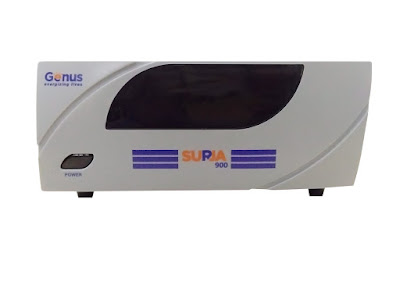How does a Solar UPS for Home Work?
A power inverter is used to convert Direct
Current into Alternating Current using transformers. It does this by switching
and controlling circuits. Usually, a home UPS takes the direct current from the
batteries and converts it into alternating current which is later used by
electronic appliances at home.
Many people often get confused between
solar inverters and solar UPS. The term ‘Solar Home UPS’ can be used instead of
“Solar Inverter”. In countries like the USA and Australia, people won’t call Solar
Power Inverters’ as Solar UPS. But in India, people are more comfortable with
using the word “solar inverter” for “Solar UPS for home”. The job of both Solar Inverter and Solar UPS is more or less
the same.
Broadly speaking, the solar inverters that
are used in homes can be named as Solar UPS
for home because it has two built-in chargers. One is the solar charger and
the other is the grid charger. The UPS system delivers an immediate power
supply in case the grid power fails.
Working of Solar UPS for Home
A normal home UPS comes with a system of
inverter and batteries that are very well connected to the home power
connection. in case the power is coming from the grid, the role of the UPS
system is to charge the batteries using this power. In case the power is off,
DC power from the batteries is taken by the inverter and later it is converted
into AC that is further used by the appliances. The system comes with an
automated switch that senses in case the grid is not supplying power and
automatically switches the UPS into the battery mode.
The solar charge controller is a very small
device in the entire system which helps the inverter to charge the batteries
using solar panels. The solar inverter has some built-in activity that doesn’t
allow the battery to lose its discharge deeply. This ensures that the lifespan
of the battery is maintained. In the same way, the solar UPS for home also saves the battery using its in-built
functions. Because of this special feature, i.e., the solar UPS has a built-in
solar charge controller; the solar panels can be directly connected to the
solar home UPS system.
Hybrid Solar Inverter or Solar Home UPS
System
Solar Home UPS System comes with two
inbuilt chargers as mentioned earlier. A hybrid solar system allows the users
to leverage stored energy in case of a grid failure. The users can also use the
concept of net metering and save on their utility bills. People who want a continuous
power supply should go for hybrid solar inverters even if it’s a little
expensive affair. But on the other hand, the maintenance cost of a hybrid
system is much cheaper as compared to the traditional generators that are not
even environment-friendly as they use diesel as fuel.
Conclusion
As a sensible buyer, you should know your
power requirements, your spending capacity, and the kind of area you live in.
it is important to analyze and understand your needs before you invest in a Solar
UPS for your home. In case your area attracts heavy rainfall, you should look
for ways to protect solar panels from rain.



The process of installing is not as complicated as it may seem. The first step is to find out what your roof can
ReplyDeletesupport in terms of weight and size, then you have to measure the area that you want covered by the solar panels,
Afforable Solar Panels Worcester
then you have to research what kind of panel will work best for your home, then you have to purchase the panels
and have them installed by a professional.
ReplyDeletehome Solar Panels System Worcester
are a great investment for homeowners. They provide a cheaper and cleaner alternative to traditional energy sources. The process of installing is not as complicated as it may seem. The first step is to find out what your roof can support in terms of weight and size, then you have to measure the area that you want covered by the solar panels, then you have to research.
ReplyDeleteAffordable Solar In Dallas
are a great investment for homeowners. They provide a cheaper and cleaner alternative to traditional energy sources. The process of installing is not as complicated as it may seem. The first step is to find out what your roof can support in terms of weight and size, then you have to measure the area that you want covered by the solar panels, then you have to research what kind of panel will work best for your home, then you have to purchase the panels and have them installed by a professional.